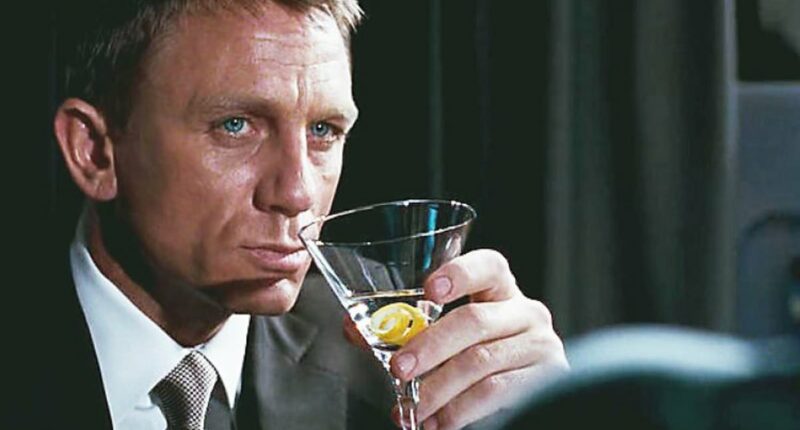Share this @internewscast.com
As any film buff will know, James Bond insists on his vodka martini being ‘shaken, not stirred’.
The iconic cocktail is made with vodka, vermouth and ice, garnished with ‘large thin slice of lemon peel’.
But it turns out that Ian Fleming’s superspy may have been ordering the classic drink all wrong.
That’s according to Darcy O’Neil, a scientist and beverage writer based in Canada, who has revealed how to make the perfect martini.
Sadly for Bond, an expert clarifies that shaking a cocktail before serving it results in smaller pieces of ice. These tiny ice shards do make the drink colder, but they also increase the risk of watering down the ingredients, which can reduce the overall taste.
‘The key difference comes down to dilution,’ Ms O’Neil, who runs the Art of Drink YouTube channel, told the Daily Mail.
‘The process of shaking is more vigorous and leads to the creation of small ice particles that melt quickly. This causes more dilution, assuming shaking and stirring times are the same,’ the expert notes.
This revelation comes amidst speculation about who might take on the role of the next James Bond, with a star from the House of Guinness being the latest to be touted by bookmakers as a possible choice.

The legendary cocktail, which Bond made famous, includes vodka, vermouth, and ice, with a large thin slice of lemon peel for garnish. While Bond didn’t invent the vodka martini, he certainly brought it to the spotlight. Pictured here is James Bond (played by Daniel Craig) in ‘Casino Royale’ (2006).
As per Schott’s Food And Drink Miscellany, a martini—traditionally crafted with gin rather than vodka—should always be ‘agitated’ with ice before being poured into a cocktail glass.
But whether this agitation should be in the form of shaking or stirring is a question that has vexed drinkers for decades.
Bond, known for his refined taste, has consistently demanded his drinks prepared this way, both in the novels and on screen. However, as Amazon takes control of the 007 franchise, there might be significant changes to Bond’s drinking preferences in the future.
In the 1958 book ‘Dr No’, he says: ‘I would like a medium Vodka dry Martini – with a slice of lemon peel. Shaken and not stirred, please. I would prefer Russian or Polish vodka.’
This is the first time the character utters his preference for shaken over stirred – assumed to be because it makes for a colder drink, helping Bond keep his cool.
But the result is that he is sipping back a more watery and aerated beverage.
According to Ms O’Neil, a shaken martini has more air bubbles, making the drink more cloudy and with a ‘thinner, less viscous mouth feel’.
‘A stirred martini is typically perfectly clear, with no air bubbles,’ he told the Daily Mail.

In the 1958 book ‘Dr No’, Bond says: ‘I would like a medium Vodka dry Martini – with a slice of lemon peel. Shaken and not stirred, please. I would prefer Russian or Polish vodka’. Pictured, Sean Connery as Bond in the 1962 film adaptation
‘People often experience a smooth, viscous sensation when drinking a stirred martini, and don’t experience that with a shaken one.’
According to the expert, small air bubbles can change the flavour and texture of the drink slightly, although they dissipate quickly.
‘Depending on a person’s mood, the drink may be finished before the bubbles are gone,’ he said.
English writer William Somerset Maugham was one connoisseur who appreciated a difference, but unlike Bond he opted for a stirred martini.
Maugham once said a martini ‘should always be stirred, not shaken, so that the molecules lie sensuously on top of one another’ – but O’Neil thinks he ‘was using some literary license when expressing that statement’.
Vermouth, vodka and gin are miscible, meaning they form a homogeneous mixture when added together, he pointed out.
‘So from a chemistry point of view, they will disperse evenly amongst each other,’ he said. ‘And the key molecules are ethanol and water, which make up 99.9 per cent of a martini.’
In his 2022 book Love and Let Die, cultural historian John Higgs says shaking a martini is perceived by some to ‘bruise’ the gin, giving a bitter taste, but how exactly the drink is prepared is perhaps less important than how resolute Bond is in his choice.

A shaken martini has more air bubbles, making the drink more cloudy. Pictured, Pierce Brosnan as Bond in ‘Die Another Day’ (2002)
‘It is not whether this is the best drink that matters here,’ Higgs said. ‘It is that Bond needs to believe that he knows what is best.’
To cocktail purists, Bond also commits something of an offence by ordering vodka in his martini instead of the more traditional gin – although in the first Bond book he opts for both.
Bond can’t take credit for creating the vodka martini, but he certainly popularized it.
‘It was a drink specially chosen to express Bond’s modern sophistication – he does not drink whisky or brandy like the older establishment, neither does he drink anything common like beer,’ Higgs said.
‘Bond’s drink of choice became so iconic because of what it said about his character – that he recognised quality and the minutiae of the material world.
‘This has kept Bond ordering martinis in the films long after the associations they had in the 1950s had gone.’









